
Welcome to the ezine produced by SGI Buddhists that prompts the positive, kindles the constructive, highlights the hopeful and leaves you feeling - well, up!

 On 20 January 2009 Barak Hussein Obama will be inaugurated as the USA's 44th and first African-American President. It is a historical event, not just for America but for the whole world, writes Vida Adamoli
On 20 January 2009 Barak Hussein Obama will be inaugurated as the USA's 44th and first African-American President. It is a historical event, not just for America but for the whole world, writes Vida Adamoli
Barak Obama, who accepted the Democratic Party's nomination for President on the 45th anniversary of Martin Luther King's ‘I Have a Dream' speech, represents the culmination of a centuries-long struggle. A struggle fought on the battlefields of slavery, civil rights and continuing racial inequality. Many of his supporters see him as a ‘post-racial’ candidate, a man of unity and inclusion, reaching beyond colour to deliver a message of hope and positive change for all people. Here we take a look at some of the trailblazing African-Americans whose achievments made Obama's epoch-making achievement possible.
Civil Rights
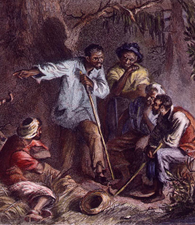 Nat Turner (1800 –1831), born into slavery, was leader of the largest slave rebellion. He was singularly intelligent and learned to read and write at a young age. Deeply religious, he believed he was called by God to free his enslaved people. With a small band of fellow slaves – which grew to include more than fifty enslaved and free blacks – the rebels travelled Virginia freeing slaves and killing every white person they met. The rebellion was put down after 48 hours. Nat escaped and went into hiding. He was eventually captured and, on November 11 1831, executed by hanging. His body was flayed, behea,ded and quartered.
Nat Turner (1800 –1831), born into slavery, was leader of the largest slave rebellion. He was singularly intelligent and learned to read and write at a young age. Deeply religious, he believed he was called by God to free his enslaved people. With a small band of fellow slaves – which grew to include more than fifty enslaved and free blacks – the rebels travelled Virginia freeing slaves and killing every white person they met. The rebellion was put down after 48 hours. Nat escaped and went into hiding. He was eventually captured and, on November 11 1831, executed by hanging. His body was flayed, behea,ded and quartered.
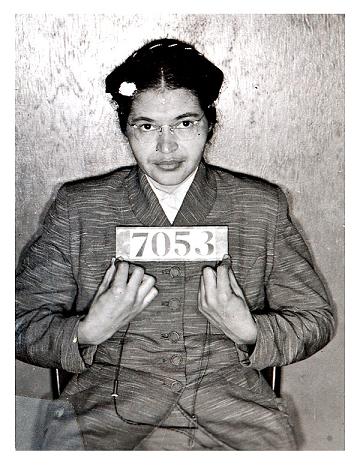 Rosa Parks (1913 –2005), the ‘Woman
Who Changed a Nation’. On December 1, 1955 in Montgomery, Alabama,
Parks refused to obey bus driver James Blake's order that she give up
her seat to make room for a white passenger. This of defiance created
the modern Civil Rights Movement and Parks became an international icon
of resistance to racial segregation. She went on to receive many
honours ranging from the 1979 Spingarn Medal to the Congressional Gold
Medal. Her statue stands in the United States Capitol's National
Statuary Hall and she was awarded the posthumous honor of lying in
state at the Capitol Rotunda.
Rosa Parks (1913 –2005), the ‘Woman
Who Changed a Nation’. On December 1, 1955 in Montgomery, Alabama,
Parks refused to obey bus driver James Blake's order that she give up
her seat to make room for a white passenger. This of defiance created
the modern Civil Rights Movement and Parks became an international icon
of resistance to racial segregation. She went on to receive many
honours ranging from the 1979 Spingarn Medal to the Congressional Gold
Medal. Her statue stands in the United States Capitol's National
Statuary Hall and she was awarded the posthumous honor of lying in
state at the Capitol Rotunda.
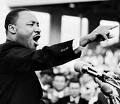 Martin Luther King (1929 – 1968) was an American clergymen, Nobel Peace Prize winner and one of the principal leaders of the American civil rights movements. In 1955 he helped mobilise the black boycott of the Montgomery bus system after Rosa Parks’s took her famous stand. Inspired by Gandhi, he advocated the use of non-violent direct action. In 1963 he was arrested for leading mass protests in Birmingham, Alabama, where the white population were violently resisting desegregation. After his release, King joined the enormous civil rights march on Washington and delivered his famous 'I have a dream' speech. With the increasing radicalization of the civil rights movement, however, many of the younger generation rejected his message of peaceful protest. He was assassinated on 4 April 1968 in Memphis, Tennessee.''
Martin Luther King (1929 – 1968) was an American clergymen, Nobel Peace Prize winner and one of the principal leaders of the American civil rights movements. In 1955 he helped mobilise the black boycott of the Montgomery bus system after Rosa Parks’s took her famous stand. Inspired by Gandhi, he advocated the use of non-violent direct action. In 1963 he was arrested for leading mass protests in Birmingham, Alabama, where the white population were violently resisting desegregation. After his release, King joined the enormous civil rights march on Washington and delivered his famous 'I have a dream' speech. With the increasing radicalization of the civil rights movement, however, many of the younger generation rejected his message of peaceful protest. He was assassinated on 4 April 1968 in Memphis, Tennessee.''
 Jessie Jackson became a civil rights activist while still a student. Later he was a field worker with the Southern Christian Leadership Conference (SCLC) and in 1965 took part in the Selma to Montgomery march. An ordained a Baptist minister, Jackson concentrated civil rights and served as SCLC's national director. In 1971 he founded People United to Save Humanity (PUSH), an organization advocating African-American self-help. In 1983-84, his bid to become the first African-American president collapsed when he failed to receive the Democratic Party nomination.
Jessie Jackson became a civil rights activist while still a student. Later he was a field worker with the Southern Christian Leadership Conference (SCLC) and in 1965 took part in the Selma to Montgomery march. An ordained a Baptist minister, Jackson concentrated civil rights and served as SCLC's national director. In 1971 he founded People United to Save Humanity (PUSH), an organization advocating African-American self-help. In 1983-84, his bid to become the first African-American president collapsed when he failed to receive the Democratic Party nomination.
Scientists/Architects
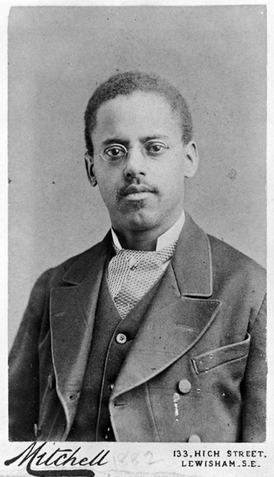 Lewis Latimer (1848-1928) was the son of George and Rebecca Latimer, escaped slaves from Virginia. He enlisted in the Union Navy at the age of 15 by forging the age on his birth certificate. On returning to civilian life, he got a job with Crosby & Gould, patent solicitors. At the same time he studied drafting, eventually became their head draftsmen. In 1874, he co-patented an improved toilet system for railroad cars.In 1876, Alexander Graham Bell employed Latimer to draft the drawings required to receive a patent for Bell's telephone..In 1881 he received a patent for the ‘Process of Manufacturing Carbons’, an improved method for the production of carbon filaments for lightbulb. Latimer is an inductee of the National Inventors Hall of Fame for his work on electric filament manufacturing techniques.[
Lewis Latimer (1848-1928) was the son of George and Rebecca Latimer, escaped slaves from Virginia. He enlisted in the Union Navy at the age of 15 by forging the age on his birth certificate. On returning to civilian life, he got a job with Crosby & Gould, patent solicitors. At the same time he studied drafting, eventually became their head draftsmen. In 1874, he co-patented an improved toilet system for railroad cars.In 1876, Alexander Graham Bell employed Latimer to draft the drawings required to receive a patent for Bell's telephone..In 1881 he received a patent for the ‘Process of Manufacturing Carbons’, an improved method for the production of carbon filaments for lightbulb. Latimer is an inductee of the National Inventors Hall of Fame for his work on electric filament manufacturing techniques.[
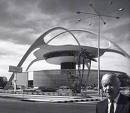 Paul Williams (1884 - 1980), renowned for designing major buildings such the Los Angeles International Airport and over 2000 homes in Southern California, studied engineering at the University of Southern California and won an important architecture competition when he was only 25. Three years later he opened his own practice. At that time the social and economic barriers faced by African-Americans was enormous. In 1930 black registered architects numbered around sixty. His style has been described as ‘the last word in elegant traditionalism..’
Paul Williams (1884 - 1980), renowned for designing major buildings such the Los Angeles International Airport and over 2000 homes in Southern California, studied engineering at the University of Southern California and won an important architecture competition when he was only 25. Three years later he opened his own practice. At that time the social and economic barriers faced by African-Americans was enormous. In 1930 black registered architects numbered around sixty. His style has been described as ‘the last word in elegant traditionalism..’
 Norma Merrick Sklarek is an African American architect She was the first black woman to be licensed as an architect in the United States with certification in the state of New York in 1954 and then in the state of California in 1962. She was the first black woman to be elected Fellow of the American Institute of Architects in 1980. Another first, she was the first African-American director of architecture at Gruen and Associates in Los Angeles, CA and she also worked with the Jon Jerde Partnership. In 1985, she became the first African-American woman architect to form her own architectural firm, Siegel, Sklarek, Diamond. Among Sklarek's designs are the San Bernardino City Hall in San Bernardino, California, the Fox Plaza in San Francisco, Terminal One at the Los Angeles International Airport and the Embassy of the United States in Tokyo, Japan.
Norma Merrick Sklarek is an African American architect She was the first black woman to be licensed as an architect in the United States with certification in the state of New York in 1954 and then in the state of California in 1962. She was the first black woman to be elected Fellow of the American Institute of Architects in 1980. Another first, she was the first African-American director of architecture at Gruen and Associates in Los Angeles, CA and she also worked with the Jon Jerde Partnership. In 1985, she became the first African-American woman architect to form her own architectural firm, Siegel, Sklarek, Diamond. Among Sklarek's designs are the San Bernardino City Hall in San Bernardino, California, the Fox Plaza in San Francisco, Terminal One at the Los Angeles International Airport and the Embassy of the United States in Tokyo, Japan.
 Benjamin Banneker (1731-), whose father and grandfather were former slaves, was a modest farmer who lived a life of unusual achievement. In 1753, he dismantled a pocket watch borrowed from a well-to-do neighbour; making drawings of each component before returning it fully functioning to its owner. Using the drawings he created wooden replicas of each part, constructing a clock that kept accurate time and struck the hours for over fifty years. At age 58, Banneker began the study of astronomy and was soon predicting future solar and lunar eclipses. ‘Benjamin Banneker's Almanac’ was a top seller from Pennsylvania to Virginia and even into Kentucky. Despite the popular prejudices of his times, this inspirational man refused to let his race or age obstruct his quest for intellectual development. In 1980, the U.S. Postal Service issued a postage stamp in his honor.
Benjamin Banneker (1731-), whose father and grandfather were former slaves, was a modest farmer who lived a life of unusual achievement. In 1753, he dismantled a pocket watch borrowed from a well-to-do neighbour; making drawings of each component before returning it fully functioning to its owner. Using the drawings he created wooden replicas of each part, constructing a clock that kept accurate time and struck the hours for over fifty years. At age 58, Banneker began the study of astronomy and was soon predicting future solar and lunar eclipses. ‘Benjamin Banneker's Almanac’ was a top seller from Pennsylvania to Virginia and even into Kentucky. Despite the popular prejudices of his times, this inspirational man refused to let his race or age obstruct his quest for intellectual development. In 1980, the U.S. Postal Service issued a postage stamp in his honor.
Music
 Marion Anderson (1897-1993) was a contralto opera singer refused entry to an all-white music school because she was black. She sought training elsewhere and in 1925 debuted with the New York Philharmonic, scoring an immediate success with both public and critics. In the early 1930s a tour of Europe added to her growing reputation. She was received everywhere with great enthusiasm - the famous Italian conductor, Arturo Toscanini, described her voice as 'heard once in a hundred years' - and there was none of the racial predjudice she had to deal with in America. Marion Anderson went on to become the first African-American to perform with the New York Metropolitan Opera. In 1972 she was awarded the UN Peace Prize.
Marion Anderson (1897-1993) was a contralto opera singer refused entry to an all-white music school because she was black. She sought training elsewhere and in 1925 debuted with the New York Philharmonic, scoring an immediate success with both public and critics. In the early 1930s a tour of Europe added to her growing reputation. She was received everywhere with great enthusiasm - the famous Italian conductor, Arturo Toscanini, described her voice as 'heard once in a hundred years' - and there was none of the racial predjudice she had to deal with in America. Marion Anderson went on to become the first African-American to perform with the New York Metropolitan Opera. In 1972 she was awarded the UN Peace Prize.
Duke Ellington--one of America's most prolific and, arguably, greatest composers--was the first jazz musician to produce extended compositions. His work elevated the jazz idiom and remains among the most durable sounds of the 20th century.
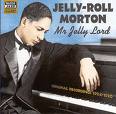 Jelly Roll Morton liked to call himself the "inventor of jazz." And while that moniker may be a bit hyperbolic, there is no denying his influence. The pianist-bandleader stood at the intersection of ragtime, blues and folk music and fused the sounds into a new symphony that certainly fueled the imaginations and stirred the souls of the jazz greats who followed and later eclipsed him.
Jelly Roll Morton liked to call himself the "inventor of jazz." And while that moniker may be a bit hyperbolic, there is no denying his influence. The pianist-bandleader stood at the intersection of ragtime, blues and folk music and fused the sounds into a new symphony that certainly fueled the imaginations and stirred the souls of the jazz greats who followed and later eclipsed him.
 Louis Armstrong was not only a musical genius--a master of improvisation and the defining "voice" of jazz trumpet-style--he was one of the greatest ambassadors of his art form. Both his singing and instrumental innovations influenced the growth and development of jazz, and spawned countless imitators through the ages.
Louis Armstrong was not only a musical genius--a master of improvisation and the defining "voice" of jazz trumpet-style--he was one of the greatest ambassadors of his art form. Both his singing and instrumental innovations influenced the growth and development of jazz, and spawned countless imitators through the ages.
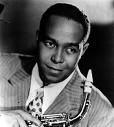 Charlie 'Yardbird' Parker was one of the architects of the musical revolution that was bebop. A composer and instrumentalist of unparalleled genius, his superb musicianship elevated jazz from mere dance music to an art form that required serious listening. His last public performance was on March 5 1955, at Birdland, a New York nightclub named in his honour. He died a week later.
Charlie 'Yardbird' Parker was one of the architects of the musical revolution that was bebop. A composer and instrumentalist of unparalleled genius, his superb musicianship elevated jazz from mere dance music to an art form that required serious listening. His last public performance was on March 5 1955, at Birdland, a New York nightclub named in his honour. He died a week later.
Performing Arts
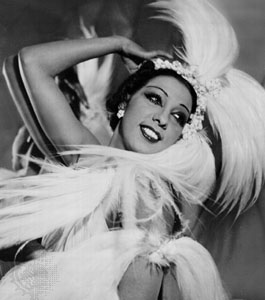 Josephine Baker (1906-1975) was born to a washerwoman and a vaudeville drummer in St Louis, Missouri. At the age of 13 she started touring with The Jones Family band, honing her dancing and comedic skills. Later she went on to achieve moderate success at the Plantation Club in New York. The turning point came in the 1920s when she left for Paris to take part in the new La Revue Negre. Sashaying on to the stage she wowed audiences with her mixture of comic and sensual appeal. She ending up taking the whole of Europe by storm. Famous for
barely-there dresses and no-holds-barred dance routines, her exotic
beauty generated nicknames "Black Venus," "Black Pearl" and "Creole Goddess."
Admirers bestowed a plethora of gifts, including diamonds and cars,
and she's said to have received 1500 marriage proposals. Unfortunately, racism prevented her talents from
being wholly accepted in the United States until 1973. She married three times and adopted twelve children.
Josephine Baker (1906-1975) was born to a washerwoman and a vaudeville drummer in St Louis, Missouri. At the age of 13 she started touring with The Jones Family band, honing her dancing and comedic skills. Later she went on to achieve moderate success at the Plantation Club in New York. The turning point came in the 1920s when she left for Paris to take part in the new La Revue Negre. Sashaying on to the stage she wowed audiences with her mixture of comic and sensual appeal. She ending up taking the whole of Europe by storm. Famous for
barely-there dresses and no-holds-barred dance routines, her exotic
beauty generated nicknames "Black Venus," "Black Pearl" and "Creole Goddess."
Admirers bestowed a plethora of gifts, including diamonds and cars,
and she's said to have received 1500 marriage proposals. Unfortunately, racism prevented her talents from
being wholly accepted in the United States until 1973. She married three times and adopted twelve children.
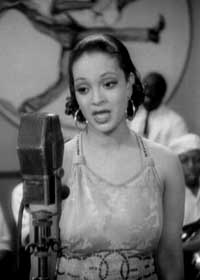 Nina Mae McKinney (1913-1967) was America's first black movie star. While still a teenager, she was spotted working as a dancer by the director King Vidor. Impressed by her beauty and sex appeal, he gave her the lead female role in Hallelujah!,
one of the first all-black films by a major studio. During her day she was called 'The Black Garbo' and her popularity rivalled Josephine Baker's. Lack of leading roles for African-American performers forced her to leave Hollywood for Europe, however, where she forged a career in theatrical shows and cabaret.
Nina Mae McKinney (1913-1967) was America's first black movie star. While still a teenager, she was spotted working as a dancer by the director King Vidor. Impressed by her beauty and sex appeal, he gave her the lead female role in Hallelujah!,
one of the first all-black films by a major studio. During her day she was called 'The Black Garbo' and her popularity rivalled Josephine Baker's. Lack of leading roles for African-American performers forced her to leave Hollywood for Europe, however, where she forged a career in theatrical shows and cabaret.
 Harry Belafonte, born 1927, is a Jamaican-American musican and actor. One of the most successful popular singers in history, he was dubbed the 'King of Calypso' for popularing Caribbean music in the 1950s. Belafonte was the first black man to win an Emmy with his 1959 TV special, Tonight with Belafonte. His long, acclaimed film and music career earned him the Kennedy Center Honors award in 1989, the National Medal of Arts award in 1994 and a Grammy Lifetime Achievment Award. Like many civil rights activists, he was blacklisted during the McCarthy era. He bailed King out of the Birmingham City Jail and raised thousands of dollars to release other imprisoned civil rights protesters. He financed the Freedom Rides, supported voter registration drives and helped to organize the 1963 March on Washington. He has been an outspoken critic of Geroge W Bush and the IraqWar.
Harry Belafonte, born 1927, is a Jamaican-American musican and actor. One of the most successful popular singers in history, he was dubbed the 'King of Calypso' for popularing Caribbean music in the 1950s. Belafonte was the first black man to win an Emmy with his 1959 TV special, Tonight with Belafonte. His long, acclaimed film and music career earned him the Kennedy Center Honors award in 1989, the National Medal of Arts award in 1994 and a Grammy Lifetime Achievment Award. Like many civil rights activists, he was blacklisted during the McCarthy era. He bailed King out of the Birmingham City Jail and raised thousands of dollars to release other imprisoned civil rights protesters. He financed the Freedom Rides, supported voter registration drives and helped to organize the 1963 March on Washington. He has been an outspoken critic of Geroge W Bush and the IraqWar.
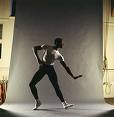 Arthur Mitchell (born New York,1934) is a dancer, teacher, choreographer, artistic
director and the first black principal dancer in a leading ballet company,
the New York City Ballet. He also established Dance Theatre of Harlem, the first major ballet company to feature black classical dancers. He also became a soloist, and later celebrated artistic director, with the company George Balanchine. Mitchell earned an international reputation,
appearing as a guest artist with ballet companies in Canada and in
Europe and serving as artistic director for the Companhia Nacional de
Brazil in Rio de Janeiro. His performances with the New York City Ballet disproved racial prejudices
that judged blacks unfit for ballet. He received
numerous awards and honors during his career, including a Capezio Dance
Award in 1971, The Kennedy Center Honors in 1993, and a lifetime
achievement award from the School of American Ballet in 1995.
Arthur Mitchell (born New York,1934) is a dancer, teacher, choreographer, artistic
director and the first black principal dancer in a leading ballet company,
the New York City Ballet. He also established Dance Theatre of Harlem, the first major ballet company to feature black classical dancers. He also became a soloist, and later celebrated artistic director, with the company George Balanchine. Mitchell earned an international reputation,
appearing as a guest artist with ballet companies in Canada and in
Europe and serving as artistic director for the Companhia Nacional de
Brazil in Rio de Janeiro. His performances with the New York City Ballet disproved racial prejudices
that judged blacks unfit for ballet. He received
numerous awards and honors during his career, including a Capezio Dance
Award in 1971, The Kennedy Center Honors in 1993, and a lifetime
achievement award from the School of American Ballet in 1995.
Literature
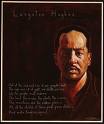 Langston Hughes (1902 –1967) was a poet, novelist and playwright who became one of the foremost interpreters of racial relationships in the United States. Influenced by the Bible, W. E. B. Du Bois, and Walt Whitman, Hughes depicted realistically the ordinary lives of black people. Hughes's poems were often written in rhythmical language. He intended them to be read aloud, crooned, shouted and sung. Like many black writers and artists of his time, was drawn to the promise of Communism as an alternative to a segregated America. Hiis first novel, Not Without Laughter, published in 1930, won the Harmon Gold Medal for literature. It was followed by his first collection of short stories, The Ways of White Folks, which express a pessimistic view of race relations. Hughes was a prolific writer of novels, poetry and plays. His poem The Negro Speaks Out has been among the most quoted of all poems by a black poet.
Langston Hughes (1902 –1967) was a poet, novelist and playwright who became one of the foremost interpreters of racial relationships in the United States. Influenced by the Bible, W. E. B. Du Bois, and Walt Whitman, Hughes depicted realistically the ordinary lives of black people. Hughes's poems were often written in rhythmical language. He intended them to be read aloud, crooned, shouted and sung. Like many black writers and artists of his time, was drawn to the promise of Communism as an alternative to a segregated America. Hiis first novel, Not Without Laughter, published in 1930, won the Harmon Gold Medal for literature. It was followed by his first collection of short stories, The Ways of White Folks, which express a pessimistic view of race relations. Hughes was a prolific writer of novels, poetry and plays. His poem The Negro Speaks Out has been among the most quoted of all poems by a black poet.
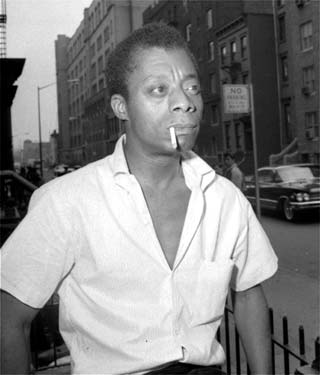 James Baldwin (1924–1987) born in Harlem, New York, was a novelist, writer, playwright, poet and essayist. Most of his work deals with racial and sexual issues in the mid-20th century United States. His novels are notable for the personal way in which they explore questions of identity as well as for the way in which they mine complex social and psychological pressures related to being black and homosexual well before the social, cultural or political equality of these groups was improved. In 1948, disillusioned by American predjudice against blacks and gays, he transferred to Paris, France, where he lived for most of his life. His novels include Go Tell it on the Mountain, Giovanni’s Room, Another Country and Harlem Quartet.
James Baldwin (1924–1987) born in Harlem, New York, was a novelist, writer, playwright, poet and essayist. Most of his work deals with racial and sexual issues in the mid-20th century United States. His novels are notable for the personal way in which they explore questions of identity as well as for the way in which they mine complex social and psychological pressures related to being black and homosexual well before the social, cultural or political equality of these groups was improved. In 1948, disillusioned by American predjudice against blacks and gays, he transferred to Paris, France, where he lived for most of his life. His novels include Go Tell it on the Mountain, Giovanni’s Room, Another Country and Harlem Quartet.
 Toni Morrison, born to a working class family in Ohio in 1931, is a Nobel Prize-winning author, editor and professor. Her novels are known for their epic themes, vivid dialogue, and richly detailed black characters. Notable among these are The Bluest Eye, Song of Solomon, and Beloved, which won the Pulitzer Prize for Fiction in 1988. Beloved was adapted into the 1998 film of the same name starring Oprah Winfrey and Danny Glover. In 1993 Morrison was awarded the Nobel Prize in Literature, the first black woman to win it. Her citation reads: Toni Morrison, ‘who in novels characterized by visionary force and poetic import, gives life to an essential aspect of American reality.’ In 2002, scholar Molefi Kete Asante included Toni Morrison in his list of 100 Greatest African Americans.
Toni Morrison, born to a working class family in Ohio in 1931, is a Nobel Prize-winning author, editor and professor. Her novels are known for their epic themes, vivid dialogue, and richly detailed black characters. Notable among these are The Bluest Eye, Song of Solomon, and Beloved, which won the Pulitzer Prize for Fiction in 1988. Beloved was adapted into the 1998 film of the same name starring Oprah Winfrey and Danny Glover. In 1993 Morrison was awarded the Nobel Prize in Literature, the first black woman to win it. Her citation reads: Toni Morrison, ‘who in novels characterized by visionary force and poetic import, gives life to an essential aspect of American reality.’ In 2002, scholar Molefi Kete Asante included Toni Morrison in his list of 100 Greatest African Americans.
 Maya Angelou, born in St. Louis, Missouri, in1928, is an accomplished poet, an award-winning writer, a journalist, an activist, a performer, a dancer, an actress, a director, and a teacher. She is also a three-time Grammy Award winner for her autobiographical spoken-word recordings. Born in St. Louis, she was raised in Stamps, Arkansas, and then went to San Francisco. She lives in Harlem, NY, and Winston-Salem, NC. In addition to her bestselling autobiographies, beginning with I Know Why the Caged Bird Signs, she is the author of Letter to my Daughter; several poetry collections, including Shall Not Be Moved and Shaker, Why Don't You Sing?; and a number of books for young readers, including Kofi and His Magic; My Painted House, My Friendly Chicken and Me; and the Maya's World series.
Maya Angelou, born in St. Louis, Missouri, in1928, is an accomplished poet, an award-winning writer, a journalist, an activist, a performer, a dancer, an actress, a director, and a teacher. She is also a three-time Grammy Award winner for her autobiographical spoken-word recordings. Born in St. Louis, she was raised in Stamps, Arkansas, and then went to San Francisco. She lives in Harlem, NY, and Winston-Salem, NC. In addition to her bestselling autobiographies, beginning with I Know Why the Caged Bird Signs, she is the author of Letter to my Daughter; several poetry collections, including Shall Not Be Moved and Shaker, Why Don't You Sing?; and a number of books for young readers, including Kofi and His Magic; My Painted House, My Friendly Chicken and Me; and the Maya's World series.
Sport
 Harry ‘Bucky’ Lew (1884-1963) was born in to a family that had long been active in the struggle for racial equality. He made his mark as the first African American to play professional basketball. After leading the local YMCA team to a Merrimack Valley championship, he played defence for the Pawtucketville Athletic Club in the New England Basketball League. According to one of his teammates, he was ‘the best double dribbler he had ever seen’. When the League folded, Lew stayed in the game, working as a player and general manager for his own Lowell-based teams. In 1928, he moved to Springfield. One of the pioneers of basketball, he has never been inducted into the Hall of Fame, located just a few miles from where he spent the last 35 years of his life.
Harry ‘Bucky’ Lew (1884-1963) was born in to a family that had long been active in the struggle for racial equality. He made his mark as the first African American to play professional basketball. After leading the local YMCA team to a Merrimack Valley championship, he played defence for the Pawtucketville Athletic Club in the New England Basketball League. According to one of his teammates, he was ‘the best double dribbler he had ever seen’. When the League folded, Lew stayed in the game, working as a player and general manager for his own Lowell-based teams. In 1928, he moved to Springfield. One of the pioneers of basketball, he has never been inducted into the Hall of Fame, located just a few miles from where he spent the last 35 years of his life.
integrate professional
 John Baxter Taylor (1882–1908) was an American track and field athlete, notable as the first African-American to win an Olympic gold medal. A graduate of the University of Pennsylvania, School of Veterinary Medicine, and the most prominent African American member of the Irish American Athletic Club, he was a member of the gold medal medley relay team at the 1908 Summer Olympics in London. He advanced to the finals in the men's 400 metres race, winning his preliminary heat with a time of 50.8 seconds and his semi-final with 49.8 seconds. Less than five months after his triumphant return, Taylor died of typhoid fever on 2 December 1908 at the age of 26. In his obituary, The New York Times called him ‘the world's greatest negro runner.’
John Baxter Taylor (1882–1908) was an American track and field athlete, notable as the first African-American to win an Olympic gold medal. A graduate of the University of Pennsylvania, School of Veterinary Medicine, and the most prominent African American member of the Irish American Athletic Club, he was a member of the gold medal medley relay team at the 1908 Summer Olympics in London. He advanced to the finals in the men's 400 metres race, winning his preliminary heat with a time of 50.8 seconds and his semi-final with 49.8 seconds. Less than five months after his triumphant return, Taylor died of typhoid fever on 2 December 1908 at the age of 26. In his obituary, The New York Times called him ‘the world's greatest negro runner.’
 Mohamed Ali (born Cassius Marcellus Clay Jr, on January 17, 1942) will go down in history as one of the greatest boxers of all time. Three-time World Heavyweight Champion, he was also the winner of an Olympic Light-heavyweight gold medal. Ali was known for his great hand speed, swift feet and taunting tactics. He described his fast, sharp fighting style ‘float like a butterfly, sting like a bee’. A masterful self-promoter, Ali defeated almost every top heavyweight in his era, which has been called the golden age of heavyweight boxing. He is an inductee into the International Boxing Hall of Fame and holds wins over seven other inductees. In 1999 he was crowned ‘Sportsman of the Century’ by Sports Illustrated and the BBC(Cassius Clay)
Mohamed Ali (born Cassius Marcellus Clay Jr, on January 17, 1942) will go down in history as one of the greatest boxers of all time. Three-time World Heavyweight Champion, he was also the winner of an Olympic Light-heavyweight gold medal. Ali was known for his great hand speed, swift feet and taunting tactics. He described his fast, sharp fighting style ‘float like a butterfly, sting like a bee’. A masterful self-promoter, Ali defeated almost every top heavyweight in his era, which has been called the golden age of heavyweight boxing. He is an inductee into the International Boxing Hall of Fame and holds wins over seven other inductees. In 1999 he was crowned ‘Sportsman of the Century’ by Sports Illustrated and the BBC(Cassius Clay)
 Jackie Robinson (1919 –1972) was the first African-American Major League Baseball player of the modern era. His 1947 Major League debut with the Brooklyn Dodgers ended approximately 60 years of baseball segregation. He thrilled fans, shattered baseball's colour barrier and changed the face of the nation. During his exceptional career he played on six World Series teams and in 1962 was inducted into the Baseball Hall of Fame. He earned six consecutive All-Star Game nominations and won several awards during his career. Later he was appointed the Major League’s first African-American Baseball analyst. In 1950, he played himself in the biographical film The Jackie Robinson Story. He was posthumously awarded the Presidential Medal of Freedom and the Congressional Gold Medal.
Jackie Robinson (1919 –1972) was the first African-American Major League Baseball player of the modern era. His 1947 Major League debut with the Brooklyn Dodgers ended approximately 60 years of baseball segregation. He thrilled fans, shattered baseball's colour barrier and changed the face of the nation. During his exceptional career he played on six World Series teams and in 1962 was inducted into the Baseball Hall of Fame. He earned six consecutive All-Star Game nominations and won several awards during his career. Later he was appointed the Major League’s first African-American Baseball analyst. In 1950, he played himself in the biographical film The Jackie Robinson Story. He was posthumously awarded the Presidential Medal of Freedom and the Congressional Gold Medal.

